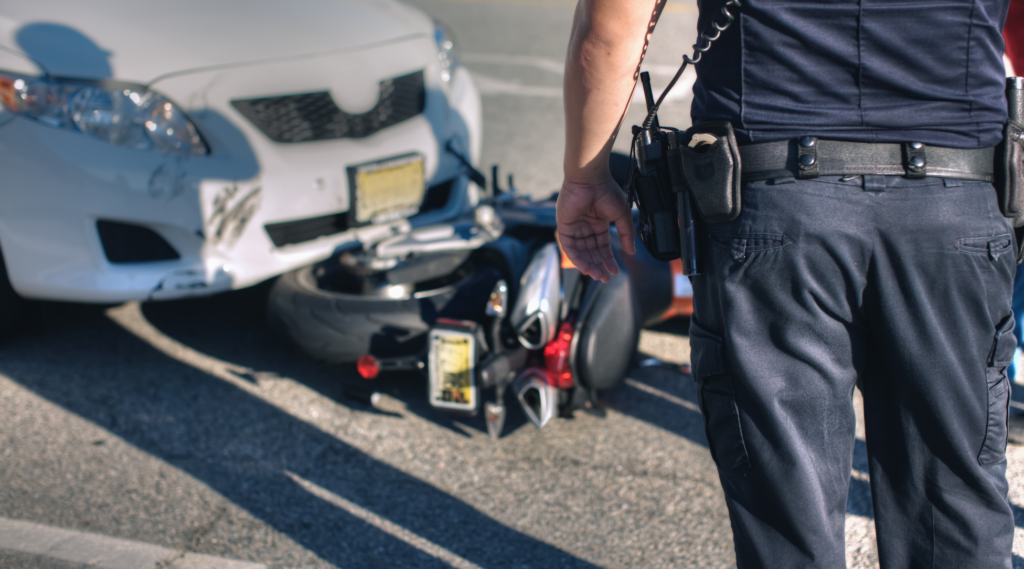Knowing the general number, and how it compares to recent years, is only the beginning. Numbers don’t tell the real story behind the scenes. Are the causes of the accidents the same year over year, or are new contributions being added? Let’s look at what the major causes are before we share some tips:
What Contributes to Most Motorcycle Accidents?
There are many factors that lead to a higher chance of having or being in an accident on a motorcycle. Before you mention gender, age, time of day, alcohol, or weather, one should first consider the education and skill of the rider. A rider with more skill and more education should be less likely to be involved in an accident, whether it’s a single vehicle or multiple vehicle accident. Beyond skill and education, these factors contribute most to motorcycle accidents:

Age
Twenty years ago, thankfully all four age ranges in the statistics were under 40% of the total motorcycle fatalities. That meant that riders under the age of 30 had reached a new low contribution level and have continued to stay on a lower trend. Over the last 15 years, riders from 30-50 years old have stayed consistent with a slow decline. While the younger riders have continued to decrease in fatality numbers every year, another age range had to increase over the same time. Since the early 1990s, riders over the age of 50 have continued to increase in fatalities every year and stayed above 1,500 lives lost in all of the last 8 years.
 Gender
Gender
Time of Day
Based on the numbers, the time of day you ride can have a significant contribution to your likelihood of being involved in an accident. During the weekdays, you would expect that rush hour traffic is heaviest and would potentially have a big contribution to fatalities. More vehicles on the road should indicate a higher potential, and the statistics correlate in that regard. From 12 pm to 12 am, there is a clear distinction in the number of fatalities on the roads. Roughly 7 out of 10 fatalities occur after 12 pm on a weekday, and the 3 pm – 6 pm hours account for 24%. If you plan to ride on the weekends, be aware that the same trend continues. The afternoon hours up until midnight account for 3 out of 4 fatalities on the weekends with the 6 pm – 9 pm hours accounting for almost 1 in every 4 fatalities.
Drinking and Riding
Alcohol involvement doesn’t always equate to having or being involved in an accident, but based on the statistics, having a blood alcohol level of 0.08 or more can be a factor leading to a fatality. Of the riders lost in 2017, roughly 1 in 3 had a BAC of 0.08 or more. A BAC of 0.08 is usually the legal limit before it becomes a crime in most states. Of those riders, about 60% had a BAC of 0.15 or more. That’s almost double the legal limit allowed. Time of day does also has a contribution to the statistics surrounding alcohol. Nearly half of the riders with a BAC of 0.08 or more lost their lives between 9 pm and 6 am, which is when daylight is gone, animals may be out on the roadside the most, and weather can play more of a factor with fog, ice, or rain. Alcohol and riding are a poor mixture, especially when other factors can pile on the danger.
Single vs. Multiple Vehicle Crashes
Motorcycle fatalities on the road don’t always require other vehicles involved. For every 5 fatalities on a motorcycle, 2 only involved the motorcyclist. They are listed as single-vehicle accidents. There are many factors that can contribute to a single-vehicle accident on a motorcycle, but the main contributor is always the motorcyclist. Out of those 5 fatalities, the other 3 involve one or more other vehicles. They don’t have to be in motion to be involved, but most likely it’s another vehicle being driven on the road. These accidents can again have similar causes, but other contributions can be offered when other vehicles share the roadway. The one main factor, in either case, is the rider themselves. Their actions while riding have the best chance to keep them out of an accident, whether they are sharing the roadway with other vehicles or riding alone.
Engine Size
Engine size is a tricky subject because it doesn’t always equate well to the risk of an accident or fatality while riding. Engine size is broken down into three categories: 1,000cc and under, 1,001 – 1,400cc, and 1,400cc and over. What you typically see is newer riders generally buy motorcycles in the 1,000cc or less category. They are fresh from a training class with a minimal amount of experience and have a high risk of an accident. Over the last 20 years, the 1,400cc and over category has trended higher and higher year after year. There aren’t many motorcycles that fit into this category, and those that do are most likely a touring motorcycle that sees a lot of seat time over the course of a year. More time on the road would offer more chances for an accident to occur, which makes sense.
Time of Year
The time of year definitely shows a trend leading to motorcycle accidents and fatalities. When it’s cold, fewer riders are on the road. January to March shows only a single-digit incident rate of fatalities. October through December show a similar trend. That leaves the warmest months of the year where the most riding fatalities occur. April through September have double-digit fatality rates each month with July as the single highest month at 14% from 2017. July is usually one of the warmest months during the summer, and with the 4th of July holiday usually offering an extended weekend, riders are out on the roads heavily enjoying great weather. Expect higher rates in warmer weather and also expect lower rates when weather is inclement or poor for riding.
What body part experiences the most injuries?
This one is hard to quantify as only head injuries are classified and recorded. In most accidents, there will be bruises, scrapes, and cuts. The rider may not have a head injury from an accident, and that is usually not recorded in any statistics. The usual body parts outside of the head that incur injury are the hands (riders usually try to catch themselves with their hands), their feet and ankles (they are already close to the ground and could be trapped under the motorcycle in a fall), and the shoulders and arms. That’s not to say that knees, hips, and backs won’t be injured, but the highest likelihood comes from the extremities.
Does Location Matter?
Looking over the statistics, location in the United States appears to make a difference. By looking through the numbers for every state, you can see a large correlation between coastal states, warmer climates, and the number of registered riders. California, Florida, and Texas are the top three states in the U.S. for fatalities. You can also say that the warmer climates and longer riding seasons in those states could make the chances of having a fatal accident more likely. More riding time could potentially mean more accidents occurring throughout the year. Conversely, you have states like Vermont, Wyoming, Delaware, and Utah that may not offer the same riding weather during the year and have a shorter riding season. That could contribute to their low fatality numbers compared to those higher in the rankings. [2]
If you look at metrics inside the states instead of what state it is, you can find that there is a clear distinction between urban (city) and rural (country) sections of each state. Urban and rural areas can both contain interstates/freeways, major roads, and minor roads. In urban areas, you may think that the highways and freeways would have the highest fatality rates because they should have the highest speed of the three options. The statistics show that only 1 in 10 fatalities occur on a highway or freeway in an urban area. Shockingly, major roads not considered an interstate claimed three times more lives in 2017. Rural areas of each state show that major roads and minor roads are equally dangerous, both claiming 18% of the fatalities in 2017. The rural highway sections claim a significantly smaller amount at just 2%.
The Addition of Automobiles
We previously mentioned that motorcycles can be included in multiple vehicle crashes. The majority of those will involve automobiles or light trucks on shared roadways. One question that comes up is accountability for causing the crash. Is there a trend showing that motorcycles or automobiles are causing accidents more often than not? The FARS data for 2017 is inconclusive. You can determine the number of accidents involving multiple vehicles, if the automobile driver was listed as distracted by anything, or if the motorcyclist was distracted. The numbers don’t conclusively point at either, but the fact that multiple options for distractions are available in the statistics indicate it is a problem on shared roads.
By sharing roadways between automobiles and motorcycles, one could ask if automobiles have the same fatality rate as motorcycles. The simple answer is no. Passenger vehicle occupants show a fatality rate of 23,708 for 2017 while motorcycle fatalities added up to 5,172. With approximately 8 million motorcycles registered and more than 254 million registered vehicles sharing the road [4], the motorcycles riders show a fatality rate of almost seven times more likely to be killed on the roads. That’s a staggering number of riders lost every year and a big risk to take when riding.
Of those that lost their lives in 2017, 91% of them were males and those males were 99.5% likely to be the driver of the motorcycle. The remaining 9% of motorcyclists were females, and 60% of them were passengers. That means that just 5% of the fatalities were passengers, regardless if they were male or female. Could you think that motorcycling is mostly as driver activity with passengers less often joining in? Maybe, but it could also indicate that drivers ride differently when a passenger is aboard. It’s inconclusive without further study, but passengers shouldn’t be worried that they are taking more risk than the driver.
Conclusion
With all those numbers listed, that is a lot of data to take in. You could make a case that if you’re in a certain age group, a certain gender, or ride in certain areas, that you may open yourself up to more risk as a motorcyclist. Safety gear (remember ATGATT), safety in situations, and safety in your decisions. If that is first and foremost your concern while riding, you’ll put thousands of miles on your motorcycle every year with minimal risk. Be safe out there!
NHTSA Database:
https://www.nhtsa.gov/research-data/fatality-analysis-reporting-system-fars
References:
https://www.iihs.org/iihs/topics/t/motorcycles/fatalityfacts/motorcycles/2017 [1]
https://www.ghsa.org/sites/default/files/2018-05/ghsa_motorcyclists18.pdf [2]
https://www.iii.org/article/background-on-motorcycle-crashes [3]
https://en.wikipedia.org/wiki/Passenger_vehicles_in_the_United_States [4]

